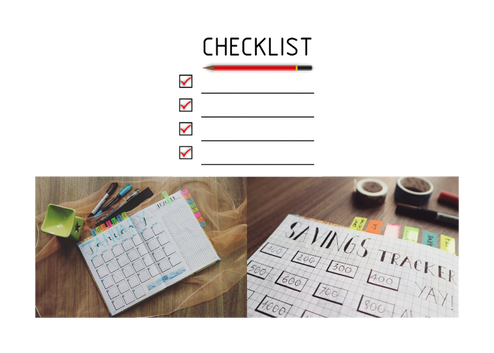Exclusive Access Granted To Our Blog!
|
You know that low-content products can help boost income and generate leads, but you’re not sure where to start. Any business can create and sell a low-content product. Popular formats can be customized to suit any industry, niche, or business – even yours. What all Customers/Clients Have in Common Low-content products have universal appeal because, as people, we share these things in common:
Think about these motivating factors as you customize your own low-content product. Here are three of the most popular low-content products and specific ways you can customize each to suit your business. Planner People love planners (or, at least, the idea of them). There are several ways you can customize planners suit any business and audience. Theme: What is your niche? What product or service do you provide? Add your unique stamp to the planner by personalizing it. For example, if you are a career coach specializing in midlife transitions, you can create a planner called ‘Your Midlife Transition Planner’. Layout/Design: What imagery or fonts would your audience be more receptive to? What would work best with your brand, niche, and industry? For example, if you provide executive coaching, a floral theme with an elaborate script font might not be appropriate. Content: Common elements in planners can include a to-do section; condensed monthly calendar; daily, monthly, or weekly targets or priorities; appointments; gratitude list; and more. Think about the elements you want to include and how you can put a personal, brand-relevant spin on them. Checklists Checklists are a valuable tool to keep people on track. They are also very simple to create. Theme: Again, focus on your niche. What product or service do you provide? Create a checklist based on a process you typically use, or for a specific task or list relevant to your niche. For example, if you are a life coach who specializes in cultivating an abundance mindset, you might create the ‘Positive Morning Routine’ checklist. Layout/Design: Use fonts, graphics, and colors that suit the theme and audience. If the checklist is aspirational or inspirational, you can let your imagination run a bit wild. If it’s a task-oriented checklist, keep it more traditional and professional. Content: Depending on your topic, the checklist could be as simple as a tick box next to each item on a list. If you are creating a checklist for a complex process, add columns next to each task. For example, columns for quantity, time, or notes. Tracker Theme: Create a tracker based on goals you want your target audience to measure and complete. For example, if you are a career coach, create a habit tracker or business development tracker. Layout/Design: As in all your low-content pieces, incorporate your branding into the tracker. That way, if it’s shared, or appears on Google Images, people know who created it. Stick to your brand colors so it will seamlessly integrate into other pieces or promotions. Content: Incorporate methods of measurement and rewards that are relevant to your niche. For example, if you are career coach helping people with behavioral changes, add a progress bar to the tracker to motivate them to keep going. Pat Simes is a Business Strategist, blogger and Founder of Innovative Business Solutions and Innovate Academy. She currently resides in the Midwest and is committed to inspiring and empowering entrepreneurs to transform their vision to reality. Website: providing-innovation.com
0 Comments
Low-content products, like ready-made templates, workbooks, journals, or logs, contain limited content but can produce unlimited results and motivation – for you, and the customer. Their short, powerful messages, images, or tasks are proven to spur people into action. And because they are so easy to produce, you’ll be motivated to create more and boost your income. Motivate Your Customers Low-content products can be a valuable resource for customers who want to stay motivated and make progress in their business or personal life. Customers love low-content products because they require little effort to consume, they’re interactive, and these products can summarize key points in a fraction of the time it would take to read a book. For example, someone might choose to purchase a time management journal over a full-length book because it provides a quick way to produce measurable change in their lives. They can read 1-2 lines of advice, or a quote, a question, or a summary of action steps in a just few minutes. They can then journal about it, putting what they’ve learned into their own words – which is proven to be the most powerful way to retain new material. The daily wins and the visible progress will motivate them to keep going and continue purchasing. Low-Content Motivational Products
Low-content products can also serve as a great lead magnet or add-on to your current products or services – especially if you’re a coach or consultant. Reinforce your key messages with a low-content product and help your clients get inspired and achieve success. This creates a positive association with you and your brand. You will then reap the benefits. Motivate Yourself Low-content products can also propel you towards success. They are an excellent way to supplement your income, attract new leads, reinforce key teachings, boost how much people spend at check out, and so much more. And you can experience these benefits almost instantly because low-content products are so easy to create. Success breeds success, and the quick returns you’ll experience will encourage you to keep moving forward. Low-content products are incredibly motivating. Seeing something completed and ready to sell in such a short period of time will inspire you to reach greater heights in all aspects of your business. Low-Content Motivation for Creators Low-content products require… Very little time. Go from idea generation to sales within a few days. Minimal technical knowledge. Easily create your low-content products in applications you are already familiar with. Minimal upfront investment. You can create a low-content product at practically zero cost. Or, outsource their creation at an affordable price. No inventory. If your low-content product is in digital format, you’ll never run out, experience shipping delays, or invest significant funds up front. Even if you produce a physical version, you can wait until the orders come in and print on demand. The uncomplicated nature and fast turnaround of low-content products can motivate you, and your customers, to reach higher levels of success. Pat Simes is a Business Strategist, blogger and Founder of Innovative Business Solutions and Innovate Academy. She currently resides in the Midwest and is committed to inspiring and empowering entrepreneurs to transform their vision to reality. Just because low-content products are quick and easy to produce, they shouldn’t look that way. Your low-content products need to convey a professional and polished image. Because low-content products don’t have a high word count, some customers may already be skeptical about their value. A hastily assembled product that looks like an amateur created it won’t help matters. If your low-content products convey high value, customers are more likely to purchase it. Don’t overlook design. Customers will often see a preview image of your product, either on your website, email, social media page, or even on an online marketplace. People make snap judgments, and if your branding and design isn’t up to par, people won’t click and buy. The following 5 tips will help you quickly and affordably create a low-content product that not only delivers value, but looks good. Follow Basic Design Principles You don’t have to be a professional designer to create a low-content product, but you do need to keep in mind some basic design principles. If you don’t, it will immediately signal to people that this is not a professional product and they’ll be less likely to purchase it. Incorporate white space. The most common mistake non-designers make is cramming too much information, or too many graphics, into one space. Let your layout breathe. Whether it’s a checklist, to-do list, infographic, or mind map, make sure you create distance between the various elements of your low-content product. Limit yourself to 2-3 fonts. Most people use one font for the body copy, 1 font for headers, and then the third font is usually in their logo or personal branding. Use fonts that convey professionalism and style. For example, stay away from Comic or Times New Roman. Add graphics that align with the topic, your audience, and your brand. In most cases, keep it simple, understated, and professional. Incorporate Your Branding Don’t forget to incorporate your branding so people remember who created this helpful low-cost product. Add your logo and tagline, either somewhere at the top of the document, or on a cover page or title page if you have one. Add your contact information at the bottom of the document or on the back page. Include your email address, website, and social media handles. Customize an Existing Template If you need a little help, visit free, online design tools like Canva or Snappa. They have a selection of professionally designed, free templates that you can customize to suit your needs. Modify the color palette, font, or images to suit your purposes and your brand. Keep It Simple Don’t try to fit too much into one product or try to get too fancy with your design. People want a clean, easy to follow document that looks professional and polished. They don’t need anything elaborate. Outsource It Another option is to outsource some, or all, of your low-content products. This will ensure that they look professional, and that the layout and design match the quality of your content. You can find affordable designers on freelancer sites like Fiverr, Upwork, or DesignCrowd. Low-content products are a powerful way to generate income and leads. But just because they are low-content, doesn’t mean they should be low-value. Always prioritize professional, clean design. Pat Simes is a Business Strategist, blogger and Founder of Innovative Business Solutions and Innovate Academy. She currently resides in the Midwest and is committed to inspiring and empowering entrepreneurs to transform their vision to reality. Low-content products are a powerful way to generate income and leads. However, to be successful, your low-content product needs to provide customers with value. If it doesn’t deliver on what the title or marketing materials promise, customers won’t continue to buy from you. Here are 5 ways to ensure that your low-content isn’t low value. Solve a Problem When you solve someone’s problem, you provide enormous value. Get to know your audience and understand their unique issues. If you’re a career coach, maybe your clients need help managing their time. Or, if you’re a health and fitness coach, clients might be pulling muscles when they lift weights. Discover their issues and then work to solve them through your low-content product. Listen to your followers on social media, make note of questions they frequently ask you, or use online tools to see what your target audience is searching for on Google. Once you’ve narrowed it down, create a low-content product that will help solve that problem – or at least one aspect of that problem. For example, you can create a time management journal, a warm-up routine checklist, or a weight-lifting tracker. Teach a Tactic Give somebody a tangible skill that they can apply in their daily life, and you’re giving them something extremely valuable. Again, review your target audience and choose a single problem to solve or one step towards a dream that you can help them achieve. Then, figure out how to boil that down into one helpful, effective low-content product that will deliver a quick win and measurable progress. Create a tip sheet, habit tracker, illustrated how-to, or success calendar. Help them Achieve a Common Goal Low-content products are great add-ons to courses or bootcamps – any situation where you have a group of people working towards the same goal. Choose one of the goals you’ve set for your audience and create a low-content product out of it. Clients will find the product extremely valuable because it will help them stay focused, reinforce what they’ve learned, or boil down the most important points. This could take the form of a checklist, infographic, how-to, customizable templates, and more. Soothe a Worry What do your customers worry about? What are their pain points? Answer that and you’ll be able to create a high-value, low-content product. Do they worry that they’ll never be able to transition to another job? Or that they’ll never build muscle and gain confidence? Create a low-content product that is inspirational and motivational, focusing more on steps that will address feelings or insecurities, instead of a more tangible how-to product. Make them feel something and you’ll convince them of your product’s value. Create a journal with motivational quotes, daily affirmations, daily gratitude journal, and more. Make it Look Professional This final tactic to ensure that your low-content product isn’t low-value is more about appearances rather than content. You can give the best tips in the world or develop the most efficient, succinct how-to, but if it looks unprofessional, customers won’t find value in it. Find a template online or outsource your low-content product and ensure that it looks professional and polished. If you provide your customers with value, and present your products in a way that demonstrates value, you’ll be well on your way to low-content product success. Pat Simes is a Business Strategist, blogger and Founder of Innovative Business Solutions and Innovate Academy. She currently resides in the Midwest and is committed to inspiring and empowering entrepreneurs to transform their vision to reality. You’re convinced that low-content products are an effective way to generate leads and income, but you’re just not sure how to implement them in your own business. What kind of low-content products will prospects buy? Which ones will readers sign up for? Who better to answer those questions than your audience? Here are some ways to find out, from the source, which low-content products your customers and prospects are most likely to buy. You can also use these methods to determine not only the format they would be most responsive to, but also the topics they would be most interested in. Direct Research Go to your audience directly and find out which low-content products they are most likely to purchase. For this kind of product exploration, it’s best not to speak to them one-on-one or in focus groups, because everything is theoretical at this point. They might just agree to all your concepts, not willing to say ‘that’s a bad idea’ to your face. Instead, conduct anonymous surveys or polls to get accurate, unbiased opinions. Surveys – Conduct surveys using tools like SurveyMonkey, JotForm, or Google Forms. These, and other paid and free options, allow you to quickly create and run anonymous surveys. Many of these tools will also allow you to track responses and analyze survey data. Polls – Conduct public polls on your social media pages or on your website, allowing readers to choose from several options and clicking the ones they are most interested in. Survey and Poll Question Ideas
Indirect Research You can also conduct indirect research online. Research your followers on social media. Read the comments section, make note of the posts that are most popular, and check out the profiles of your top commenters and those who ‘like’ your posts. What problems do they have that a low-content product might help solve? Based on that information, what kind of low-content product would be most appropriate? Review your web analytics. What sections of your website or blog are they visiting the most? What topics are they interested in? How do they like to learn: through videos, bulleted summaries, infographics? What do those answers tell you about the low-content product they prefer? Check out online tools. Sites like AnswerThePublic can show you topics people are searching for related to your niche and products. Keyword Research Keyword research is valuable for SEO and it is also a great way to learn about buyer behavior. Google your niche and different low-content product ideas you’re considering. Compare the number of search results that come up for each query. For example, let’s say you are a career coach specializing in mid-life career change. Google different options and see which ones are more popular. “Mid-life career change” + bullet journal vs. “Mid-life career change” + pros and cons list. When choosing your low-content product, listen to your audience. Make sure it covers a topic they are interested in and is delivered in a format they prefer. Pat Simes is a Business Strategist, blogger and Founder of Innovative Business Solutions and Innovate Academy. She currently resides in the Midwest and is committed to inspiring and empowering entrepreneurs to transform their vision to reality. |
AuthorPat Simes Archives
July 2024
Categories
All
|





 RSS Feed
RSS Feed